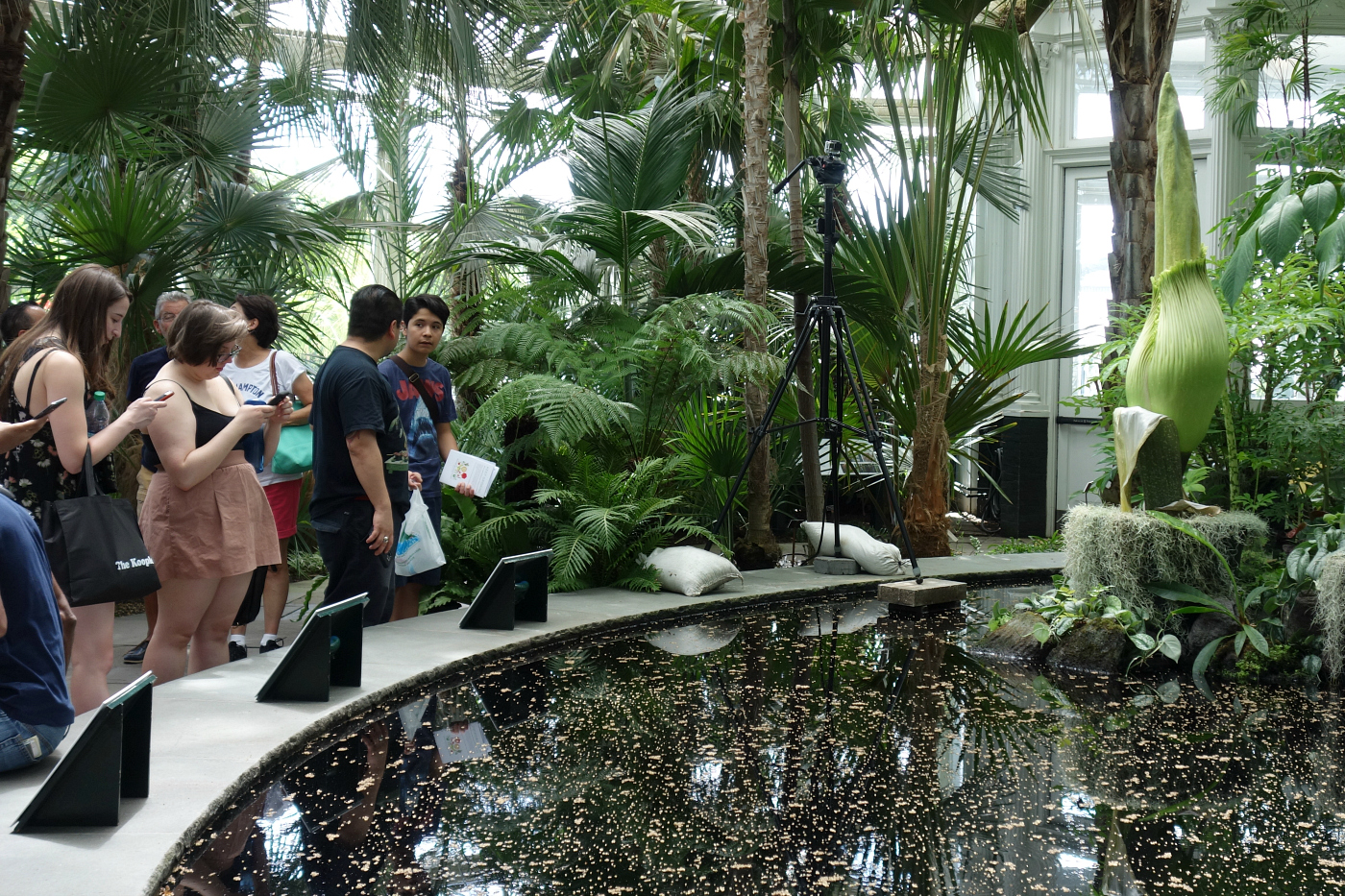
The corpse flower at the New York Botanical Garden, with two other examples of Amorphophallus titanum in different growth stages alongside (photo by the author for Hyperallergic)
Something rotten is preparing to bloom in the Bronx: one of the world’s largest flowers that smells like death. On July 18, a rare corpse flower was placed on view in the Enid A. Haupt Conservatory at the New York Botanical Garden (NYBG), the first such pungent specimen to bloom there in nearly 80 years. As of now, it’s still growing, and you can follow its progress through a live cam.

The 1889 bloom of the corpse flower at the Royal Botanic Gardens at Kew, illustrated by Matilda Smith (via Curtis’s Botanical Magazine/Wikimedia) (click to enlarge)
According to NYBG, a foul flower that blossomed there on June 8, 1937 was the first to be cultivated in the United States. Like today, it caused a media frenzy, although it was newsreels and film photographers rather than Instagrammers and television news. The flower only lasts for 24 to 36 hours, so it’s always an event. Another NYBG corpse flower bloomed on July 2, 1939, causing Bronx Borough President James J. Lyons to declare it the official flower of the Bronx. Lyons stated that “its tremendous size shall be symbolic of the large and fastest growing borough in the City of New York.” Alas, the Bronx replaced it with the daylily in 2000.
The towering Amorphophallus titanum (yes, basically Greek for “misshapen giant phallus” — it does have a striking resemblance to a whale penis) was discovered by the West when Italian naturalist Odoardo Beccari was exploring Sumatra, Indonesia, in 1878. Sumatra is the only place where the corpse flower, as it’s nicknamed for its carrion feeder-attracting scent, is indigenous. Now it’s spread its strange shape around the world, although they’re still rare as it takes between seven and 10 years of cultivation for the flower to bloom. Just this summer corpse flowers have blossomed at the Missouri Botanical Garden in St. Louis, Chico State University in California, Eastern Illinois University, Moody Gardens in Galveston Island, Texas, and the Gurukula Botanical Sanctuary in India. Along with the NYBG specimen, the US Botanic Garden in Washington, DC, has one expected to bloom between July 28 and 31 (it also has a live stream) and another nicknamed Wally is opening this month at Indiana University (yes, it has a live cam).

Illustration of the 1889 Royal Botanic Gardens at Kew corpse flower in its leaf stage, by Matilda Smith (via Curtis’s Botanical Magazine/Biodiversity Heritage Library)

Illustration of the 1889 Royal Botanic Gardens at Kew corpse flower by Matilda Smith (via Curtis’s Botanical Magazine/Biodiversity Heritage Library)
After Beccari’s discovery, the first corpse flower to be cultivated to flowering at the Royal Botanic Gardens at Kew in England was illustrated by botanical artist Matilda Smith. She had a prolific career of scientific illustration, especially for a woman in the 19th century. While she was the first to really sketch in-depth the flora of New Zealand, she also worked with the Royal Botanic Gardens for almost five decades, including as their official artist. When their inaugural corpse flower bloomed in 1889, she was there to capture its deep red coloring, which opens during its flower stage with an alien form reminiscent of a sarlacc pit. Smith also illustrated its leaf stage, when it appears like a small tree, with three plates published in Curtis’s Botanical Magazine. According to an account in the magazine, the flower smelled like “a mixture of rotten fish and burnt sugar. Many blue-bottle flies were attracted by it.”
NYBG has a handy guide to its life cycle (made by the Chicago Botanic Garden; they have 13 corpse flowers in their collections, including one nicknamed “Sprout” on view now), showing its transition from leaf to flower cycle and the resulting fruits dispersed by birds. Below, you can join the watch party for the Bronx flower through the live cam.

The 1937 corpse flower bloom at the New York Botanical Garden (via Journal of the New York Botanical Garden/Biodiversity Heritage Library) (click to enlarge)

The corpse flower at the New York Botanical Garden (photo by the author for Hyperallergic)

The corpse flower at the New York Botanical Garden (photo by the author for Hyperallergic)
Watch the bloom of the corpse floor through an online webcam, or visit the New York Botanical Garden (2900 Southern Boulevard, The Bronx).

No hay comentarios:
Publicar un comentario